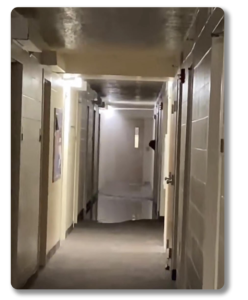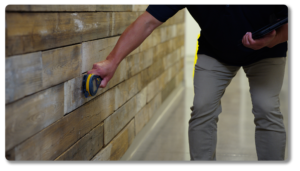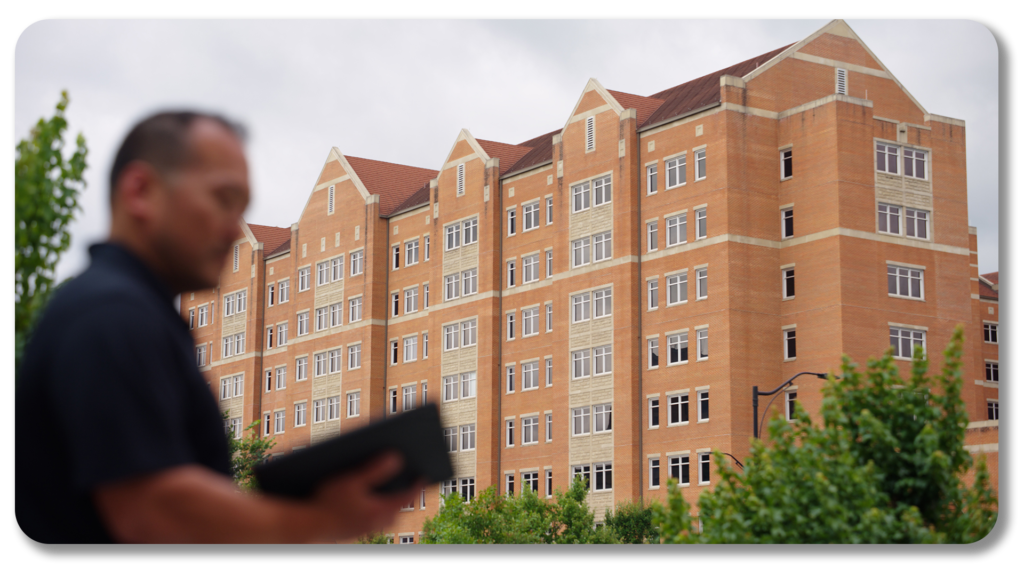Water intrusions in any facility are a common concern, but resolving emergencies in education facilities brings added complexity. With college campuses often spread over thousands of acres, encompassing hundreds of different buildings with millions of square feet of space—the sheer breadth of what could go wrong is daunting. Whether collectively or as one-off incidents, water intrusions can also have a major impact on facilities budgets and staffing, which APPA members have identified as key challenges for 2024.

When a flooding emergency occurs over a break and is not detected immediately, expensive and disruptive collateral damage can include mold, mildew, serious structural issues, and health risks for occupants. Above: flooding in a dorm.
Flooding in a dorm room, lecture hall, library, gymnasium, cafeteria, or chemistry lab each presents its own unique set of challenges. Different building materials and contents, varying schedules, and fluctuating levels of occupancy at any given time add to the problem. When a flooding emergency occurs over a break while buildings are vacated—and if not detected immediately—expensive and disruptive collateral damage can occur, including mold, mildew, serious structural issues, and health risks for occupants.
Many assume that simply having drying equipment on hand and facilities staff in place is sufficient preparation for water intrusions. But just as the range of what could go wrong is complex, advance training and response protocols should be multifaceted and thorough.
To be fully ready to respond, facilities departments must identify where preparedness is lacking and establish standardized processes and benchmarking systems. A comprehensive approach can revolutionize the way facilities prepare for and address water intrusion issues, leading to time and cost savings, and preventing space downtime that can impact students’ learning experiences and institutional reputation.
With sound practices and the right tools, facilities can leverage in-house resources to lead the charge and improve overall outcomes involving water intrusions.
An objective assessment
Most every educational facility has experienced water intrusions where response and mitigation were not perfectly executed. Staffing, communication, training, equipment, and supplies all come into play. Developing a solid system for future responses requires an honest assessment of areas for improvement.
Consider a recent incident at a large community college in California in which a major equipment malfunction led to the rapid influx of an unmanageable amount of water. A single employee was tasked with deciding on the emergency response and the best course of action. That reaction was slow, and the remediation contractor called in to help took 12 hours to arrive. That resulted in a high level of damage that could have been at least partially prevented if, for instance, all staff had been trained in the first steps for immediate response, there had been a backup plan in case this one employee was unavailable, and the proper equipment had been easily accessible onsite.
This type of scenario occurs frequently. In other cases, response plans are not fully developed and shared with all key stakeholders, or the right equipment is not available to begin fast-response water extraction. These gaps can lead to dire consequences. When the process is not efficient and thorough, building spaces can remain unusable for too long, leading to delayed classes, canceled events, and unhappy building occupants.
Conversely, identifying these gaps and learning from others’ experiences can enable educational institutions to set solid standard operating procedures (SOPs) for future success.
Identifying the gaps
The crucial first step is to conduct a full baseline evaluation of all buildings that could be impacted by water intrusion—as well as available equipment and materials needed—using an objective third party. This initial evaluation should clearly establish the current situation and help identify the critical gaps. To conduct the evaluation:
- Include a facility tour with key leadership present and an inventory of available tools and equipment.
- Detail who will respond to water damage emergencies, what staff training has taken place, how accessible equipment is, and what the current response protocols are.
- Extend to logistical details such as identifying electrical outlets for equipment, confirming their functionality, checking air quality against EPA standards, and identifying equipment storage locations.
Outside experts in water damage restoration can help navigate the assessment process and share first-hand knowledge, including common challenges and solutions as well as typical gaps in areas including staff training, communication, and equipment issues.
Of the hundreds of questions they ask during the assessment process, evaluators often get a “no” answer to these:
- Do you keep records of how each incident of water damage is resolved?
- Is all first responder equipment fully kitted (with the accessories and supplies needed) and set up?
- Do you have standard operating procedures (SOPs) for how a response plan should be deployed, including step-by-step actions and relevant contractor information?
- Are scope of work and response plan written and shared with all key stakeholders?
- Do you know the exact amount of unwanted moisture you can address in-house, with the equipment and staff available?
- Is all drying and response equipment standardized? For example, are air filtration units confirmed (via independent testing) to remove 99.99% of harmful particulates?
- Do all first responders and facilities staff understand what chemicals are being used, as well as their hazard ratings and safety precautions?
- Have all responders and staff been trained in how to use a flood extractor?
- Can all first responders and facilities staff explain how to set a “dry standard” based on unaffected areas?
- Do responders and staff know how to measure when building materials—carpets, tiles, walls, etc.—are dry?
Evaluation can uncover key strengths in addition to the gaps; both are relevant to planning. For example, during a recent evaluation at a major university, our assessors found many areas that were being handled well, such as personal protective equipment (PPE) use and record keeping. They also detailed areas needing improvement, such as equipment availability onsite, monitoring capabilities of off-hours incidents, and consistency of response protocols. These findings informed the development of a systemized approach.
Closing the gaps—putting SOPs in place
Following a comprehensive assessment of in-house capabilities, facilities departments can implement an engineered, systemized approach to set protocols for preparedness and future response. Going through this process harnesses the power of maintenance teams to address water intrusion internally—effectively and consistently.
The process should include the following elements:
- Develop detailed procedures for mitigation and restoration tasks, including step-by-step SOPs for staff action, use of cleaning agents, and deployment of water damage restoration equipment. These protocols should define precise roles and responsibilities for staff and incorporate industry best practices.
Many organizations effectively use flowcharts to outline SOPs during emergencies. For example: Locate the water source (step 1), determine whether water is clean or contaminated (step 2), then provide specific instructions for equipment selection, setup, and disinfection (subsequent steps).
Comprehensive employee training prepares facilities staff to act as effective first responders during emergencies. It includes instruction on equipment set up and operation, identifying safety hazards, preventing mold and mildew, and best practices for healthy cleaning and restoration.
In the case cited above, the university’s response protocols existed but were fractured—spread among different departments; therefore, a new, integrated response protocol needed to be developed.
- Conduct comprehensive employee training on SOPs, emphasizing the importance of timing, accuracy, and consistency. This training prepares facilities staff to act as effective first responders during emergencies and includes instruction on equipment set up and operation, identifying safety hazards, preventing mold and mildew, and best practices for healthy cleaning and restoration.
Industry partners, including the International Sanitary Supply Association and its member companies, offer hands-on training opportunities, allowing staff to gain practical experience in handling building emergencies. Additionally, brief training sessions for all building occupants can cover initial actions to take during emergencies, such as safety considerations.
- Fully inventory equipment to ensure the availability of appropriate equipment and supplies, including tools, PPE, and cleaning agents, while regularly checking and maintaining equipment to ensure optimal functionality. This should include availability of moisture inspection tools, storage space(s) for equipment, types of disinfection, and availability of commercial-grade equipment for extraction, drying, dehumidification, and air filtration.

Specialized meters designed for water damage assessment provide more accurate readings than hands “touch tests” for moisture inspections.
Cutting corners on equipment can result in extended drying times, blown fuses, and occupant health concerns. Specialized meters designed for water damage assessment provide more accurate readings than the hands “touch test” that the assessed university cited above was relying on for moisture inspections.
- Establish a robust documentation system for cleaning and restoration activities, including schedules, tasks performed, tools used, and outcomes. Comprehensive documentation facilitates progress tracking, identifies areas for improvement, and ensures compliance with safety and health regulations.
In cases where insurance claims are filed, detailed documentation is essential. Proper record-keeping is also crucial for institutional guidelines and capital planning in public environments including universities.
- Implement quality control measures through evaluations and assessments of the response program’s effectiveness at regular intervals on an ongoing basis, plus whenever new equipment is purchased or guidance (regulations, policies, etc.) changes. Gathering feedback from staff, customers, and stakeholders helps identify and address issues promptly. Note what worked and what did not work well, as well as why certain approaches did not work well. Also, are any issues isolated or systemic?
Again, objective assessments by trusted third-party sources are essential for obtaining an unbiased perspective.
- Stay up to date on emerging technologies and practices in mitigation and restoration. Incorporate new techniques and tools that enhance efficiency and convenience. Advancements in technology can streamline tasks, as exemplified in the cleaning industry, where automatic alerts now indicate low paper towel supplies. Additionally, new technologies enable remote monitoring of moisture levels and equipment functionality.
- Establish clear communication channels to keep relevant parties informed about response requirements, updates, and changes to SOPs. As the community college example showed, a key pitfall is relying on one person with institutional knowledge to serve as the go-to when an emergency occurs. Training materials, inspection reports, and corrective actions must be easily accessible to all team members. Creating a central communication system ensures efficiency and prevents duplication, especially when an incident occurs off-hours.

Observing systems succeed
Solving costly, everyday water intrusion issues by identifying gaps and setting SOPs that in-house staff can follow is an accessible, innovative approach that educational facilities can employ to reduce risk and improve outcomes.
For instance, the university in the assessment noted above immediately saw success with this approach firsthand. Soon after its evaluation was completed and standardized processes were enhanced, the institution experienced a serious water intrusion impacting luxury suites at its large stadium, which was scheduled to be used just two days later for a professional sporting event.
With an internal response system now in place, facilities staff immediately extracted water, dried down the area thoroughly, and met the deadline. If they had not closed the gaps and had the plan in place, they may have lost hours waiting on an outside contractor, and the clean-up could have taken weeks. And if action had not been taken so quickly, the intrusion could have led to far more costly and extensive damage. For a university with more than 16 million square feet of building space, the impact of having this protocol in place and these capabilities in-house is significant.
By implementing standardized processes, universities and other educational institutions can tap into their internal network of resources to address and prevent critical real-world problems. As they continue to evolve as centers of knowledge and practical experience, addressing complex challenges like water intrusion is essential to ensure these spaces remain open, safe, and healthy.
Tim Poskin is MRO (maintenance, repair, and operations) program director for Legend Brands, managing its Ready2Respond Facility Assessment Program. He is chair of the ISSA Cleaning Management Institute Workloading and Benchmarking Council and former director of the ISSA Consulting Division. Tim can be reached at 206-384-6967 or [email protected].

 Although weather-related flooding is just one cause of water intrusions in educational facilities, its impact is profound thanks to a rapidly warming planet, higher tides, and increasing storm intensity. Rising global surface temperatures increase the possibility of more droughts and more intense storms, according to the United States Geological Survey. As water vapor evaporates into the atmosphere, it fuels the development of increasingly powerful storms. Greater heat in the atmosphere and warmer ocean surface temperatures, in turn, can accelerate wind speeds in tropical storms. And rising sea levels make higher locations more vulnerable to the power of the sea and the erosive forces of waves and currents.
Although weather-related flooding is just one cause of water intrusions in educational facilities, its impact is profound thanks to a rapidly warming planet, higher tides, and increasing storm intensity. Rising global surface temperatures increase the possibility of more droughts and more intense storms, according to the United States Geological Survey. As water vapor evaporates into the atmosphere, it fuels the development of increasingly powerful storms. Greater heat in the atmosphere and warmer ocean surface temperatures, in turn, can accelerate wind speeds in tropical storms. And rising sea levels make higher locations more vulnerable to the power of the sea and the erosive forces of waves and currents.

